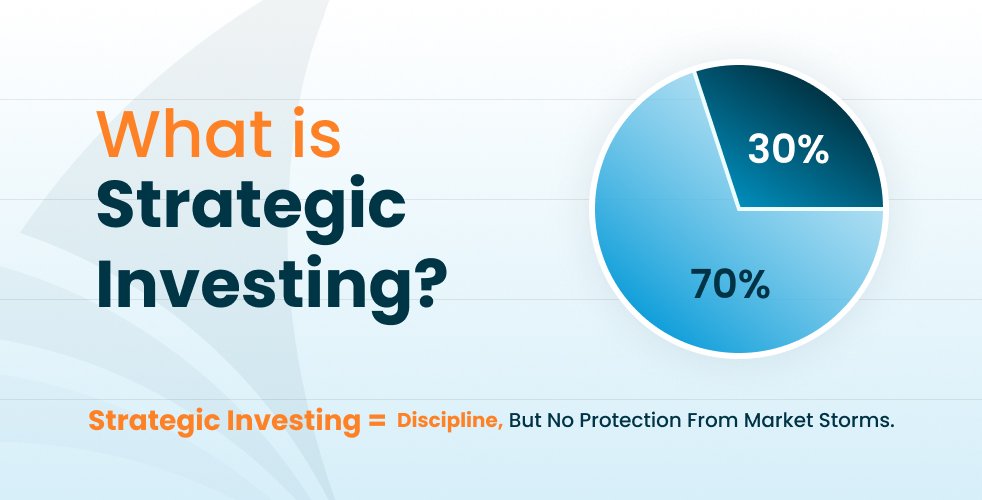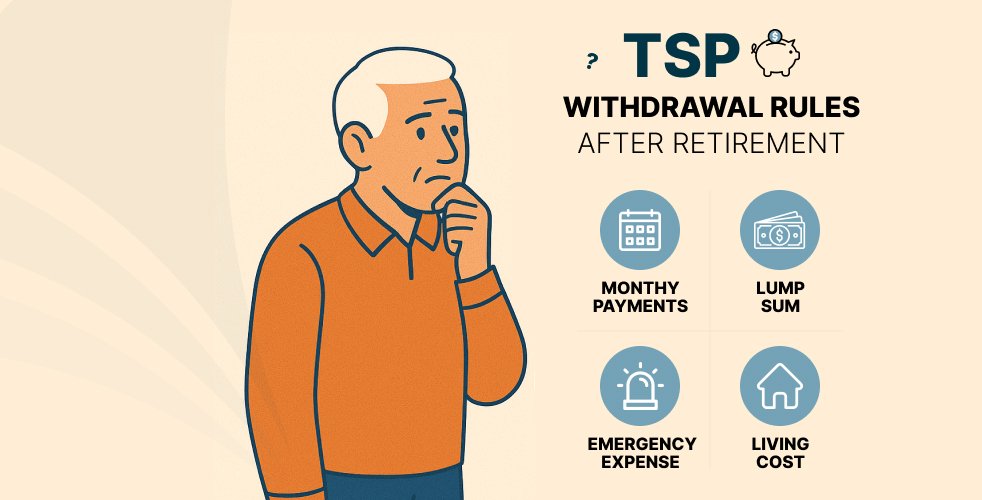
Why This Choice Matters More Than You Think
When it comes to growing and protecting your money, how you invest can be just as important as what you invest in.
For most people, investment decisions start with one big choice: Should I set my portfolio and leave it alone, or actively adjust it based on market conditions?
That’s the main point of the Strategic vs. Tactical Investing debate.
If you’ve ever been told to “just hold your investments and ride out the market,” you’ve heard the strategic investing philosophy.
If you’ve heard advice like “move into safer assets when markets look risky,” that’s the tactical side talking.
Both have their merits, but here’s the truth:
- Choosing the wrong approach for your situation could mean missing growth opportunities or suffering bigger losses than necessary.
- Understanding each method helps you make informed decisions and build a portfolio that fits your goals, risk tolerance, and lifestyle.
In this guide, we’ll break down strategic vs. tactical investing in very simple terms — no jargon, no intimidating charts.
What is Strategic Investing?
Strategic investing is like setting your GPS before a road trip and then never changing the route — no matter what traffic or weather you run into.
In the investing world, this approach is called strategic asset allocation. You decide on a target mix of investments — for example:
- 60% in stocks
- 30% in bonds
- 10% in cash or other assets
… and you keep that mix steady over the long term.
You might adjust slightly if your life changes (like nearing retirement), but you don’t change your allocation based on what the market is doing day-to-day or even year-to-year.
Why People Like Strategic Investing
- Simplicity: Set it and forget it.
- Low time commitment: No need to check the markets every week.
- Lower trading costs: Fewer transactions mean fewer fees (in some accounts).
Where Strategic Investing Can Fall Short
While the “stay the course” approach works for some, it has major limitations:
- It keeps you fully invested through every downturn, which can mean portfolio losses of 30-50% or more during severe bear markets.
- It assumes markets will recover in time for your goals — which isn’t guaranteed if you’re nearing retirement or need access to funds.
- It removes flexibility, leaving you unable to protect gains or take advantage of opportunities when conditions change.
Imagine your portfolio is 70% in stocks when a major market crash hits. If stocks drop 50%, your portfolio instantly takes a 35% hit. With strategic investing, you don’t change course — you just wait for the recovery, which might take years.
That’s where tactical investing takes a different path — one we’ll explore next.
What is Tactical Investing?
If strategic investing is like setting your GPS and sticking to the route no matter what, tactical investing is like checking the traffic and weather along the way — and taking a different route if it’ll get you there faster and safer.
In investing terms, this approach is called tactical asset allocation. Instead of locking into one fixed portfolio mix, you adjust your investments based on:
- Current market trends
- Economic conditions
- Asset performance
How It Works
Tactical investing shifts portfolio weights proactively. For example:
- If stocks are showing strong growth, you might temporarily hold a higher percentage of them.
- If indicators show a downturn ahead, you might move more into bonds or cash to protect capital.
This isn’t day trading; it’s active investing with a focus on risk management, making changes a few times a year or as conditions shift.
Why People Choose Tactical Investing
- Flexibility: You can respond to changing markets.
- Opportunity capture: You focus more on what’s performing well now.
- Loss prevention: You can reduce exposure during market downturns.
Where Tactical Investing Can Go Wrong
- Requires more time and attention than a set-it-and-forget-it strategy.
- If done emotionally or without a proven system, it can lead to poor timing and missed opportunities.
- Costs can be higher if frequent trades are made without a plan.
Let’s say your research shows signs of a recession in the next few months. With tactical investing, you could lower stock exposure early, increase cash or bonds, and avoid the full brunt of a crash — then re-enter stocks when conditions improve.
No time, experience, or expertise? No problem. Invest with confidence — let our models do the work for you.
Strategic Vs. Tactical Investing: Key Differences
By now, you’ve seen that strategic asset allocation and tactical asset allocation take very different routes toward the same goal: growing and protecting your wealth.
The big question is — which one fits you better?
Here’s a side-by-side breakdown:
| Aspect | Strategic Investing | Tactical Investing |
|---|---|---|
| Portfolio Allocation Strategy | Fixed allocation to asset classes (e.g., 60% stocks, 40% bonds), adjusted only as life stage changes | Flexible allocation that shifts based on market conditions and opportunities |
| Approach | Passive — stick to the plan regardless of market changes | Active — adapt portfolio when trends or risks emerge |
| Market Awareness | Ignores short-term conditions, focuses on long-term averages | Considers economic data, performance trends, and potential market shifts |
| Risk Management | Relies on diversification and long time horizons to weather downturns | Uses allocation changes to reduce downside and capture upside |
| Effort & Involvement | Low — minimal monitoring needed | Medium — requires periodic evaluation and decision-making |
| Potential Performance | Steady, but may miss out on gains or suffer during prolonged downturns | Can outperform in volatile markets if timing and strategy are sound |
The Core Difference
- Strategic investing is about staying the course.
- Tactical investing is about changing course when conditions call for it.
Both have their merits, and both can be executed well — but their outcomes can look very different depending on the market environment.
Example Analogy
Think of it like running a marathon:
- Strategic investors keep the same pace from start to finish, trusting it’ll get them to the end.
- Tactical investors adjust their speed — slowing down on hills, sprinting on downslopes — to conserve energy and gain an edge.
Need Help With Your Investing “Marathon”?
Tactical investing can give you an edge, but knowing when to speed up or slow down takes skill. Our proven, quantitative models act like your investment coach, guiding you through market hills and valleys so you can finish strong.
Run your retirement “marathon” smarter — let our tactical models guide the pace.
Common Mistakes Investors Make
Whether you lean toward strategic asset allocation or tactical asset allocation, there are pitfalls that can quietly chip away at your returns, and even your confidence.
Let’s go through the big ones so you can sidestep them from the start.
1. Ignoring Market Conditions Completely
- The mistake: Some investors set their portfolio and never look at it again. But market ups and downs can last for years. If too much money is in a weak asset, you could face big losses.
- The fix: Even if you prefer strategic investing, review your allocation and understand why each piece is there.
2. Overreacting to Short-Term Market News
- The mistake: Many people panic when prices drop or rush to buy when prices rise. This often means selling at low prices and buying at high prices.
- The fix: Create a rules-based plan for allocation changes (as tactical investing does) so decisions are based on strategy, not stress.
3. Misjudging Risk Tolerance
- The mistake: It’s easy to choose a portfolio without thinking about how you’ll feel if it drops 20–30%. If you can’t handle the loss, you might quit at the worst time.
- The fix: Test your comfort with different scenarios before committing. Risk management in investing isn’t just math — it’s a mindset.
4. Over-Diversifying or Under-Diversifying
- The mistake: Having too many different investments can slow growth. Putting all your money in one place can cause big losses.
- The fix: Use portfolio allocation strategies that strike a balance of enough variety to cushion losses, but enough focus to capture growth.
5. Confusing Activity with Progress
- The mistake: Changing your portfolio too often can increase costs and taxes without improving results.
- The fix: If you go tactical, have clear, rules-based triggers for changes, not just gut feelings.
Did you know?
The best investors aren’t the ones who make the perfect move every time. They’re the ones who avoid the biggest mistakes. By knowing these traps, you’re already ahead of most people.
Strategic Vs. Tactical Investing for Retirement Accounts (401(k), TSP, IRAs)
When it comes to retirement accounts like your 401(k), TSP, or IRA, the stakes are higher. These accounts often hold decades of your hard-earned savings, and the way you manage them can make the difference between retiring comfortably or having to delay your plans.
The challenge? Many retirement accounts default to strategic asset allocation through target-date funds or static mixes. That means your investments shift gradually from stocks to bonds as you age, regardless of what’s happening in the market.
Side Note: If the thought of market drops makes you uneasy, you might be surprised to learn that they can actually benefit long-term investors. Check out our article on Why You Should Look Forward to Market Declines.
How Strategic Asset Allocation Plays Out in Retirement Accounts
- The upside: Simple, “set-it-and-forget-it” approach. Less stress about constant changes.
- The downside: If a major downturn hits right before or during retirement, your portfolio may take a big hit — just when you have less time to recover.
- Example: In the 2008 financial crisis, many investors nearing retirement lost 30–40% of their portfolio value, even in “conservative” target-date funds.
How Tactical Asset Allocation Works in Retirement Accounts
- The upside: Adjusts allocations based on market conditions, aiming to reduce exposure to risky assets during downturns and increase it during growth periods.
- The downside: Requires more active monitoring and discipline to follow the plan.
- Example: A tactical strategy might have shifted heavily into bonds or cash during the COVID-19 market shock, avoiding a big loss and then rotating back into stocks as markets recovered.
Why the Difference Matters
Retirement accounts are tax-advantaged, which means fewer penalties for rebalancing compared to taxable accounts. This makes them perfect for tactical asset allocation, where adjustments happen more often.
- Strategic approach: Works if you want ultra-simplicity and are comfortable riding out every market cycle.
- Tactical approach: Works if you want to actively manage risk and protect capital in volatile markets.
Pro Tip: Even if your employer’s plan defaults to a target date fund, you can still manually adjust allocations. Understanding the basics of both approaches helps you make smarter decisions and potentially retire earlier with more money.
Why Tactical Investing Can Outperform Strategic Approaches in Volatile Markets
Market volatility isn’t just “noise.” It can have a lasting impact on your portfolio, especially if you’re near retirement or relying on your investments for income. While strategic asset allocation assumes you’ll ride out the ups and downs, tactical asset allocation aims to respond to them.
The Problem with Staying Static
A strategic approach keeps you invested in certain percentages of stocks, bonds, and other assets no matter what the market is doing.
- In long bull markets, this can mean missing out on growth because part of your portfolio is tied up in lower-performing assets like bonds.
- In severe bear markets, it means holding onto declining assets, potentially suffering losses of 30–50% that can take years to recover from.
How Tactical Investing Changes the Game
Tactical investing is like steering a ship — you adjust your sails when the wind changes, rather than locking them in place.
- In a downturn: Reduce exposure to risky assets (like stocks) and move more into defensive positions (bonds, cash, or other low-volatility assets).
- In a recovery: Increase exposure to growth assets when the trend turns positive.
This “flex and adapt” method can help you avoid the worst of market crashes while capturing more upside when conditions improve.
Love the idea of “flex and adapt” investing, but lack the time or expertise to track every move?
How Model Investing Delivers the Best of Both
When it comes to Strategic vs. Tactical Investing, many think they must choose one and commit to it for life. At Model Investing, we believe you shouldn’t have to choose, and you don’t.
Our approach is 100% tactical, but it’s built to capture the best qualities of both styles. You get the discipline and structure of strategic investing combined with the adaptability and responsiveness of tactical investing, all in one proven, rules-based system.
Strategic Discipline Built In
Just like strategic investing, our models follow a disciplined, rules-based framework for portfolio construction. We use sound portfolio allocation strategies to ensure diversification and long-term alignment with your goals.
Tactical Flexibility That Works for You
Unlike fixed strategic allocations, our tactical models adapt to market shifts, economic indicators, and asset performance. This means we can sidestep major downturns, reduce risk during turbulent times, and stay positioned for growth when markets recover.
Why This Matters
- Capture Growth: Stay fully invested during uptrends so your portfolio participates in market gains.
- Protect your gains: Reduce exposure when volatility spikes or downturns loom, helping preserve capital.
- Stay disciplined: Replace guesswork and stress with clear, data-driven signals that keep you on track.
With Model Investing, you get tactical investing that’s steady when it counts and agile when it matters most, helping you aim for market-beating returns while keeping risk under control, no matter what the market throws at you.
Want a disciplined yet adaptable way to invest?
Next Steps — See Tactical Strategies in Action
If you want to explore proven, rules-based tactical strategies that adapt to market conditions, take a look at our investment models. They’re designed to help you:
- Turn volatility into an advantage: Use market swings to your benefit instead of letting them derail your progress.
- Stay positioned for what’s next: Rotate into the strongest opportunities as conditions change, without guessing or chasing headlines.
- Grow with confidence: Build wealth consistently, knowing every move is backed by decades of research and a disciplined process.
Start your free trial today and see our tactical investing models in action.

An innovative approach for eaming higher returns with less risk
Download Report (1.2M PDF)You don’t want to look back and know you could’ve done better.
See PricingPosted in



